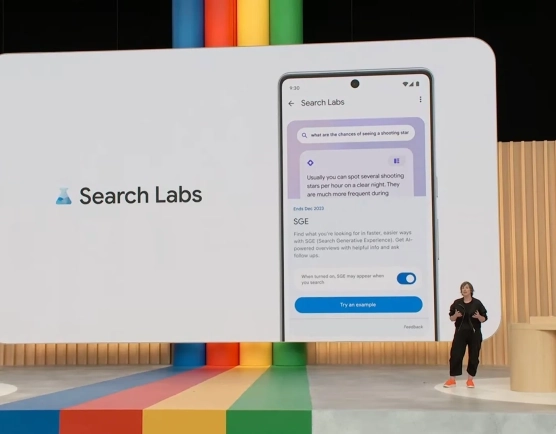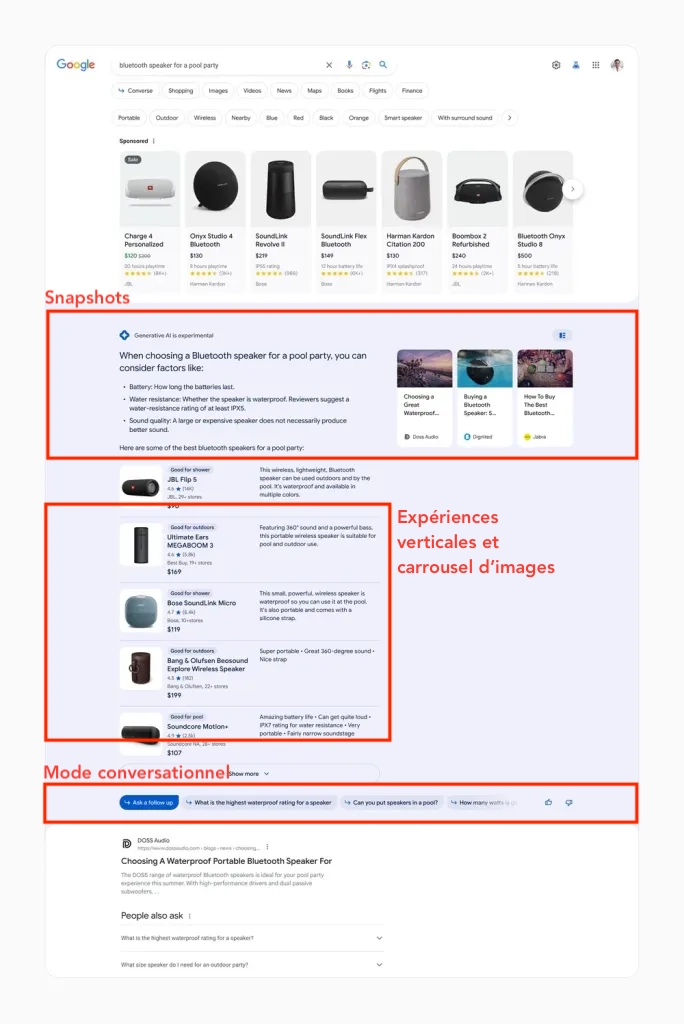


With the introduction of the Search Generative Experience (SGE) for online search, Google promises to transform our experience of the web. This breakthrough is currently being tested in the United States and is due to be launched in France in 2024. So what does this revolution mean for natural search results and SEO? How will SGE change the way we interact with search engines, and how does it affect you as a web user and professional?
Over the years, Google has introduced a number of major updates to improve the accuracy and relevance of search results. Updates such as Panda (2011), Penguin (2012) and Hummingbird (2013) were designed to penalise low-quality sites and reward those with rich, relevant content. These changes have prompted SEO professionals to optimise their strategies, focusing on content quality and good SEO practices.
More recently, Google has integrated artificial intelligence and machine learning to further refine its search results. With RankBrain (formalised in 2015) and otherAI-based systems, Google can now understand the context and nuances of search queries, offering more accurate and personalised answers.
The evolution of Search Generative Experience (SGE) is part of Google's ongoing drive to improve the search experience by leveraging advances in generative artificial intelligence. Google SGE promises a more dynamic and personalised interaction with users.

Currently, when you perform a search on Google, the search engine displays a list of websites in response to your query. Whether you're looking for general information, images or directions on Google Maps, the process is the same: Google offers you links to different sources, and it's up to you to click on these links to find the answer to your question.
With the arrival of Google SGE, this process will change. You'll type a query into Google, and instead of presenting you with a list of sites, the search engine will directly display an answer generated by artificial intelligence. This answer appears at the top of the page, saving you the need to click on several links to obtain the information you want.
What sets Google SGE apart even more is its conversational aspect. If you're not entirely satisfied with the answer generated, you can ask for clarification or additional information, just as you would with ChatGPT. Google SGE is no longer limited to being a simple answer engine; it becomes a conversational SEO partner, capable of dialoguing with you to refine its answers.
Combining the search engine with AI
Snapshots are the most notable feature of this update. When you make a request, Google SGE responds directly via a distinctive insert called a "snapshot", placed at the top of the results page with a coloured background. This insert includes text, visual elements and customer reviews. Links to websites that have contributed to the generation of this response are integrated into the snapshot via a module called "Google Expander" (a small rectangle in the top right-hand corner).
Located below the coloured pane in the snapshot, the "Ask a Follow Up" button (in reference to "ask a question in return") offers the possibility of refining your search in a conversational way. Similar to the user experience with ChatGPT, this function allows you to engage in an ongoing dialogue with the search engine.
Alongside the "Ask a Follow Up" button, you'll also find suggestions for questions frequently asked by other users who have carried out similar searches. These suggestions can be used to refine the search results.
Google is introducing an image or video carousel to enrich the search experience, by offering a visual preview directly linked to the information searched for. This feature takes the form of three thumbnails with photos or videos, located next to the generated text. Users can then quickly access relevant images or videos to complement the text answers.
For geolocalised queries, the search engine will display a "local pack" and an "SGE pack". These features provide users with a comprehensive and practical view of local businesses and the services available. The local pack presents detailed information on local establishments (location, opening hours, customer reviews), while the SGE pack enhances this information with answers to frequently asked questions. All integrated directly into the search results.

Get an SEO diagnosis of your site and identify new ways of optimising your natural referencing. Let our experts reveal your website's hidden potential!
| Positive impact | Negative impact |
The arrival of Google SGE aims to enrich and personalise the search experience for web users. It focuses on high-quality content and precise answers. The search results offered to web users are smaller, but better. The aim of this update is to promote access to the most reliable information, best suited to long-tail queries. Online searching is a more intuitive experience, similar to a conversation. At the same time, local SEO has been optimised to give users rapid access to up-to-date and relevant local information. Thanks to Google SGE, the overall user experience on the search engine becomes more fluid, engaging and informative. | Google SGE's interface, with its emphasis on immediate, visual answers, can reduce users' curiosity to search for information elsewhere on the web. By relying mainly on the quick answers provided by Google SGE, web users could find themselves limited in the diversity of viewpoints and sources of information. This risks creating a kind of "bubble" where the data they receive is mainly that chosen by Google, based on what they have previously searched for, rather than a variety of different sources. There is a risk that the information issued by the AI on the new interface may not be accurate or complete. Artificial intelligence, despite its advances, can still be prone to errors, which could mislead users or limit their understanding of a subject. |
| Positive impact | Negative impact |
Sites that produce rich, detailed and well-researched content are likely to see an improvement in their visibility and natural referencing. Unique and informative content will be valued by Google SGE, leading to an increase in qualified organic traffic. Google SGE's use of long-tail keywords gives niche sites a chance to stand out in search results. Sites that optimise their content around these keywords can capture a more targeted audience, increasing the chances of conversion and visitor retention. Businesses that regularly update their details on Google My Business and other local platforms can expect greater visibility in local searches. Being included in the new SGE pack could have a significant impact on traffic and visibility. | The emphasis on direct responses, carousels and snapshots will reduce the number of organic visits to most websites. By quickly obtaining the information they want directly from Google, visitors are unlikely to feel the need to click on sources. The increased SEO requirements in terms of quality and originality of content to meet Google SGE standards could represent a significant investment for many sites. Smaller websites and start-ups will be penalised. Finally, establishments that have not worked on their Google My Business listing (customer reviews, photos) could lose visibility and appeal in search results to companies that have optimised their SGE pack. |

In their quest for distinction and relevance, web professionals will have to develop SEO-friendly content that will capture readers' attention, encourage them to interact and share on social networks. The search intent behind the queries will be key: writers will have to fine-tune their articles to respond precisely to the requests of web users. Above all, they will need to respect Google's EEAT criteria (Expertise, Experience, Authority and Reliability) when formatting information. Unique content that engages users directly, speaks to them and answers their questions clearly, will triumph.
💡To ensure that your content effectively meets the new Google SGE requirements, you may want to consider using an experienced web copywriter or SEO consultant. They'll be able to identify and target content that needs improving to make it captivating and optimised for SEO.
Targeting long tail keywords will become a strategy for a large number of sites. To stand out from the crowd, publishers are going to have to work on articles geared towards specific (and less competitive) queries. By being closely aligned with detailed search intentions, these keywords will open the door to more qualified traffic, likely to better engage web users with the content on offer.
💡To make your long tail keyword targeting strategy a reality, start by carrying out a detailed analysis of your market niche and identify specific, less competitive queries. Use keyword research tools to discover specific phrases and questions that your target audience uses in their online searches. You can also call on an SEO expert to help you with this process.

Structured data enables information to be structured in such a way that it can be easily interpreted and exploited by Google's algorithms. Google is going to increase its use of structured data because its objective is to provide direct answers on the Google results page in the form of enriched snippets, without requiring a click to an external site.
💡Start by categorising your pages by content type: product sheet, blog post, information page. Then, in the HTML code of the pages, add clear and organised metadata for each of them. This metadata should include specific elements such as the title, description and author for a blog post, or the price, availability and reviews for a product sheet. Use the Schema.org structured data mark-up schema to ensure that your site is correctly interpreted by its algorithms.
On-page technical SEO improvements encompass a multitude of key factors: optimising the loading speed of your pages, metadata tags, information architecture and mobile responsive. These technical adjustments will improve the overall user experience and therefore the popularity of the site in the eyes of Google.
💡Let an agency with expertise in the subject work with you to monitor and improve these elements. A digital agency will be able to carry out a full technical audit of your site, identify areas requiring improvement, and implement effective solutions.
The arrival of Google SGE, with its direct answers, conversational mode and enriched visual presentations, is revolutionising the way we interact with the web. SEO professionals and web publishers need to adapt their content, keyword targeting and on-page optimisation strategies to remain competitive.
However, it is interesting to note that in the United States, SGE inserts are taking up less and less space on results pages (November 2023). This phenomenon raises the question of the possible non-adoption of this style of search result by users.
Do you have a project to create a website, mobile application or redesign? Our agency specialises in digital solutions for all sectors of activity.

